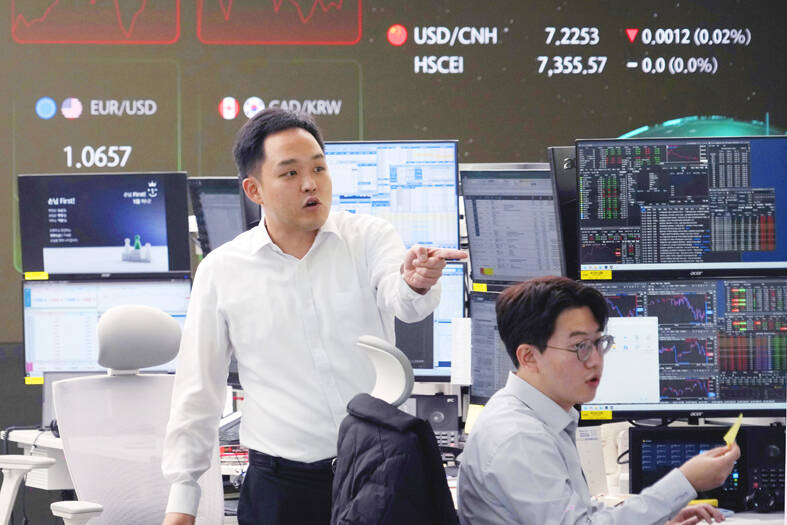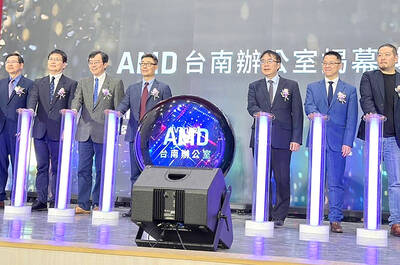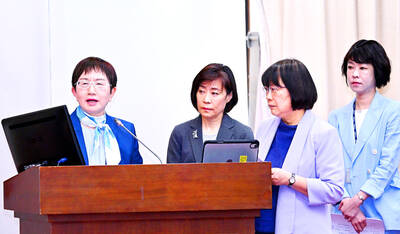The US Department of the Treasury added South Korea to a “monitoring list” for foreign exchange practices that includes Japan and Germany, and reiterated its criticism of China’s lack of transparency with regard to managing its currency.
In its semiannual foreign exchange report released on Thursday, the Treasury also concluded that “no major US trading partner manipulated the rate of exchange between its currency and the US dollar for purposes of preventing effective balance of payments adjustments or gaining unfair competitive advantage in international trade.”
The last time the Treasury designated a country as a manipulator was in 2019, under then-US president Donald Trump, when it put the label on China. The tag was dropped five months later as a bilateral trade deal was negotiated. Thursday’s is the last report under the administration of US President Joe Biden.

Photo: Ahn Young-joon, AP
The economies on the Treasury’s monitoring list were mostly unchanged from the previous release in June, and include Taiwan, China, South Korea, Japan, Germany, Singapore and Vietnam. Malaysia, which was in June’s report, was dropped in the latest one.
When a trading partner meets two of three criteria under a 2015 law, it is placed on the monitoring list for “enhanced analysis.”
South Korea was added after meeting two of the criteria, with a significant global current-account surplus and its bilateral surplus with the US, a Treasury official said.
The South Korean finance ministry declined to comment.
The won slipped as much as 0.5 percent in trading early yesterday.
The general stance of policymakers is that the exchange rate is determined by the market, but steps, or so-called “smoothing operations,” can be taken on excessive volatility. In April, South Korean authorities issued a rare warning to market participants after the won briefly weakened to a key level.
Thursday’s report covers the four quarters through June.
More recently, the US dollar has been climbing amid rising doubts about how low the US Federal Reserve would take its benchmark interest rate next year.
Expectations for faster inflation under Trump’s incoming administration, thanks in part to tariff increases, have added further impulse to the greenback this month.
That appreciation has put major strains on net importers of US dollar-priced commodities such as oil, as well as on those countries bearing US dollar-denominated debt.
While the congressionally mandated report is designed to pressure trading partners perceived to be artificially holding down their exchange rates for competitive advantage, the strong US dollar has meant that interventions around the world lately have been designed to prop up local currencies.
The Treasury reiterated its call for greater transparency in Beijing’s exchange-rate policy.
“China’s failure to publish foreign exchange intervention and broader lack of transparency around key features of its exchange rate policy make China an outlier among major economies and warrant Treasury’s close monitoring,” the department said.
A manipulator designation has no specific or immediate consequence, but the law requires the administration to engage with those trading partners to address the perceived exchange-rate imbalance.
Penalties, including exclusion from US government contracts, could be applied after a year.
In Taipei, the central bank yesterday said it has carried out its duty in line with the US recommendations that it should closely monitor non-bank financial sector risks, including foreign exchange risks.
It agreed that foreign exchange interventions should be limited and allow currency movements in line with economic fundamentals. The central bank stepped in this year mostly in support of the local currency, rather than slow its rise.
Additional reporting by Crystal Hsu

TECH CLUSTER: The US company’s new office is in the Shalun Smart Green Energy Science City, a new AI industry base and cybersecurity hub in southern Taiwan US chip designer Advanced Micro Devices Inc (AMD) yesterday launched an office in Tainan’s Gueiren District (歸仁), marking a significant milestone in the development of southern Taiwan’s artificial intelligence (AI) industry, the Tainan City Government said in a statement. AMD Taiwan general manager Vincent Chern (陳民皓) presided over the opening ceremony for the company’s new office at the Shalun Smart Green Energy Science City (沙崙智慧綠能科學城), a new AI industry base and cybersecurity hub in southern Taiwan. Facilities in the new office include an information processing center, and a research and development (R&D) center, the Tainan Economic Development Bureau said. The Ministry

ADVERSARIES: The new list includes 11 entities in China and one in Taiwan, which is a local branch of Chinese cloud computing firm Inspur Group The US added dozens of entities to a trade blacklist on Tuesday, the US Department of Commerce said, in part to disrupt Beijing’s artificial intelligence (AI) and advanced computing capabilities. The action affects 80 entities from countries including China, the United Arab Emirates and Iran, with the commerce department citing their “activities contrary to US national security and foreign policy.” Those added to the “entity list” are restricted from obtaining US items and technologies without government authorization. “We will not allow adversaries to exploit American technology to bolster their own militaries and threaten American lives,” US Secretary of Commerce Howard Lutnick said. The entities

Minister of Finance Chuang Tsui-yun (莊翠雲) yesterday told lawmakers that she “would not speculate,” but a “response plan” has been prepared in case Taiwan is targeted by US President Donald Trump’s reciprocal tariffs, which are to be announced on Wednesday next week. The Trump administration, including US Secretary of the Treasury Scott Bessent, has said that much of the proposed reciprocal tariffs would focus on the 15 countries that have the highest trade surpluses with the US. Bessent has referred to those countries as the “dirty 15,” but has not named them. Last year, Taiwan’s US$73.9 billion trade surplus with the US

The Taipei International Cycle Show (Taipei Cycle) yesterday opened at the Taipei Nangang Exhibition Center, with the event’s organizer expecting a steady recovery in the industry this year following a tough last year. This year, 980 companies from 35 countries are participating in the annual bicycle trade show, showcasing technological breakthroughs and market development trends of the bicycle industry at 3,600 booths, the Taiwan External Trade Development Council (TAITRA, 外貿協會) said in a statement. Under the theme “Ride the Revolution,” the exhibition has attracted more than 3,500 international buyers from 80 countries to preregister for the four-day event, which is expected to